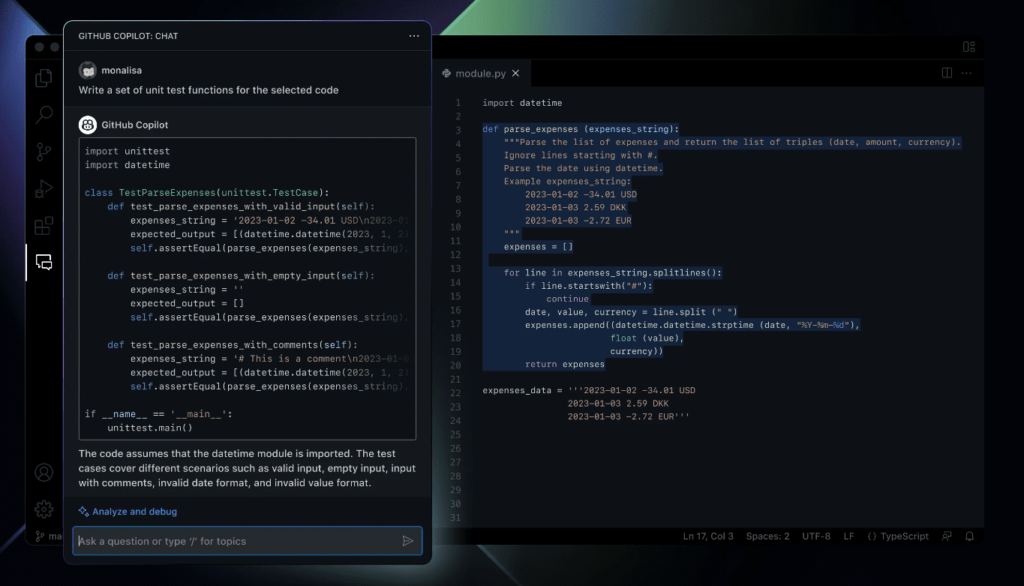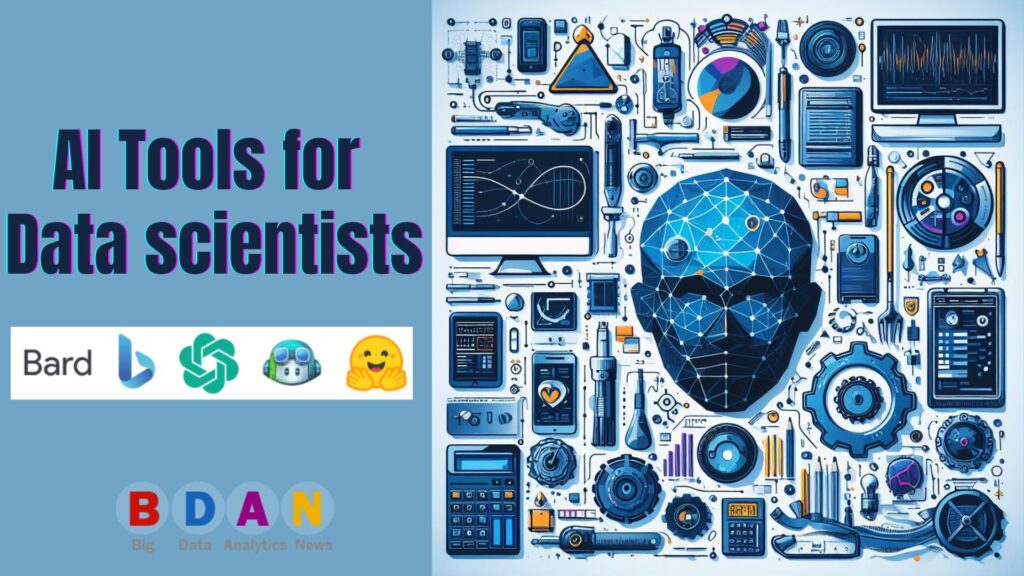10 AI Tools for Data Scientists in 2024
Explore groundbreaking AI advancements reshaping data science. Uncover the top 10 essential AI tools every data scientist should be acquainted with in this insightful article.
Why Use AI Tools?
Why Data scientists embrace AI tools for their transformative impact on data analysis. These tools, with diverse capabilities, introduce automation, precision, and enhanced predictive power, revolutionizing traditional practices. This abstract explores the compelling reasons driving data scientists to incorporate AI tools into their workflows.
The Best AI Tools for Data Science
Traversing the expansive realm of AI tools within the data science domain can be a formidable task. These tools, each with distinctive capabilities and applications, have revolutionized conventional practices by introducing automation, precision, and heightened predictive capabilities into the data analysis pipeline.
You’ve already read enough about how AI is going to be transformative. The problem is, you don’t have time to figure out which tools to use. Here are some of the top 10 AI tools every data scientist should know.
1. ChatGPT
Devised collaboratively by OpenAI and Microsoft and unveiled to the public in late 2022, ChatGPT astounded the global community with its distinctive capacity to produce human-like text across diverse genres: code, poetry, essays, document summaries, and humor. The limitless potential of ChatGPT has fueled its rapid ascent, making it the fastest-growing web application in history, achieving 100 million users within a mere two months.
ChatGPT and GPT-4 stand out as invaluable resources for data professionals. These tools prove particularly beneficial when professionals encounter challenges, offering a deep understanding of issues and presenting a relevant list of solutions.
Fueled by an expansive language model, ChatGPT has the ability to produce novels, stories, blogs, and data analytics reports, responding to user prompts. Its contextual understanding and utilization of past prompts contribute to the generation of precise and accurate results.
Read our blog: 20 ChatGPT Plugins for Data Science to learn more.
2. Bard AI
Google Bard, a chatbot feature, is poised to seamlessly integrate with Google Search and other products. It serves a versatile purpose, facilitating report writing, brainstorming, Python coding, SQL scripting, and research. Much like ChatGPT, it harnesses the capabilities of a robust language model.
Leveraging Google’s LaMDA language model, Bard AI emerges as a competitor to ChatGPT. However, notable distinctions set these two AI tools apart. While Microsoft and OpenAI have heavily invested in ChatGPT, Google’s Bard is still in its early stages, showcasing only a fraction of its ultimate capabilities. Google Bard will allow data scientists to optimize code, resolve bugs, create data charts, perform all kinds of machine learning tasks, and help them with research.

3. GitHub Copilot
GitHub Copilot is very useful for Python programmers and data professionals alike. It seamlessly autocompletes entire code segments, interprets comments to generate specific code, addresses bugs, and optimizes overall code performance.
Introducing GitHub Copilot X, your gateway to enhanced coding with GPT-4 models. Engage in context-aware conversations, craft documentation, generate pull requests, and seamlessly access frequently used commands in the CLI for an elevated coding experience.
GitHub Copilot is a programming assistant that provides coders with autocomplete suggestions. Built on top of the OpenAI Codex model, developers can use Copilot either while writing code, or by using basic natural language prompts that tell Copilot what they want the code to do.

Capable in a myriad of coding tasks, and proficient in a dozen popular programming languages, such as Python, Go, and JavaScript, GitHub Copilot opens the door for a new, more democratic way of programming, where, ironically, knowing how to code is no longer a mandatory prerequisite.
4. Bing AI
The chatbot feature within Microsoft Bing AI is a versatile tool capable of assisting in various tasks, including code generation, research, debugging, and skill acquisition. Fueled by GPT-4 and fine-tuned for search engine optimization, it offers a robust and optimized experience.
In addition to Bing Chat, the Microsoft Edge browser offers a composing feature enabling the creation of professional emails, reports, blogs, or code. However, it’s worth noting that the compose feature might not be the best choice for coding tasks.
Bing also has Dalle-E integration for text-to-image generation called Image Creator. You can use it to create a blog feature image or image for your project.
Bing Visual Search leverages the GPT-4 multimodal model, seamlessly processing both text and image inputs to deliver precise results. Unlock the ability to search for items within images or explore images across the internet with this innovative feature.
5. Hugging Face
Hugging Face stands as an open-source ecosystem offering AI tools for diverse data science tasks. Within Hugging Face Spaces, you’ll find tools for Open Source text generation, chatbot functionality, speech-to-text conversion, stable diffusion for image generation, image-to-text capabilities, visual question answering, and ChatGPT detection tools.

Hugging Face stands as an AI community and platform committed to democratizing AI access. With over 170,000 pre-trained models utilizing cutting-edge transformer architecture, and nearly 30,000 datasets, it offers data practitioners a comprehensive resource. The platform also features layered APIs, known as pipelines, facilitating seamless interaction with models. This functionality enables data professionals to conduct inference using leading AI libraries such as PyTorch and TensorFlow, all without concerns about storage or training costs.
6. Code Interpreter
Code Interpreter: OpenAI’s experimental ChatGPT model that can handle CSV data upload.
Demo:
OpenAI’s latest ChatGPT plugin revolutionizes data analysis, making everyone an instant analyst. The plugin can autonomously segment customers, decompose seasonality, and conduct linear regression. It has the ability to analyze complex datasets, such as music markets or Bitcoin price trends, and generate visually engaging outputs, like Geo Charts or heatmaps. From fetching and visualizing data from public databases to creating complex radar charts or cohort charts, this tool does it all.
It even simplifies data cleaning and natural language querying, reducing repetitive tasks and boosting productivity. Whether you’re a data scientist or a curious novice, this ChatGPT plugin transforms your data analysis experience, making it faster, simpler, and more insightful.
7. Ellie AI
Ellie AI: Make data-driven decisions with confidence.
Demo:
Ellie AI is a comprehensive data design platform, designed to infuse confidence into your data-driven decision-making processes. It equips data teams with the tools to validate business needs and establish tangible value when designing data products.
Offering features such as business and logical data modeling, a universal business glossary, seamless collaboration options, and continuous product reusability, Ellie AI serves as a catalyst in streamlining data processes across organizations.
8. ProbeAI
ProbeAI: A copilot for data analysts.
Demo:
ProbeAI acts as a supportive co-pilot for data analysts, helping with repetitive tasks like writing or fixing SQL code, and identifying the appropriate tables to query.
By automating these routine tasks, ProbeAI frees up analysts to focus on deeper, more strategic data explorations, thereby increasing overall efficiency and productivity.
9. MonkeyLearn
MonkeyLearn: Simple sentiment analysis.
Demo:
MonkeyLearn is an AI-powered text analysis tool that simplifies sentiment analysis. It employs advanced natural language processing techniques to analyze user feedback, reviews, or social media mentions.
With MonkeyLearn, you can easily clean, label, and visualize customer feedback, making it a powerful asset for understanding and responding to customer sentiments.
10. Dataiku
Dataiku: An AI and machine learning platform.
Demo:
Dataiku is a robust AI and machine learning platform that facilitates smooth collaboration between data scientists, engineers, and analysts.
It provides a comprehensive suite of tools for data preparation, exploration, model building, and deployment, making it an all-in-one solution for streamlining the data science process.
FAQs:
What are the best AI tools for data science?
Top 10 AI Data Analysis Tools
- Microsoft Azure Machine Learning.
- KNIME.
- Google Cloud AutoML.
- PyTorch.
- DataRobot.
- Talend.
- H2O.ai.
- IBM Watson Analytics.
How do data scientists use AI?
Artificial intelligence (AI) is an innovative field that aims at developing intelligent machines that can perform tasks that require something like human intelligence. Data scientists can use AI to create algorithms and models that can make predictions and automate complex tasks.2
Are there AI tools for data analysis?
Yes, there are numerous AI tools specifically designed for data analysis. These tools leverage artificial intelligence algorithms to automate processes, gain insights, and enhance the efficiency of data analysis tasks.
Which tools does data scientist use?
Data scientists commonly use a variety of tools tailored for their needs. Popular ones include Python libraries like Pandas and NumPy, visualization tools such as Tableau, machine learning frameworks like TensorFlow and PyTorch, and AI-driven platforms like Hugging Face and Google Bard.
Do all data scientists use AI?
While not all data scientists exclusively use AI, it has become an integral part of many data science workflows. AI tools, machine learning techniques, and advanced analytics play a crucial role in extracting meaningful insights from complex datasets. However, the extent to which AI is employed can vary based on the specific needs and focus of individual data scientists and their projects.




























